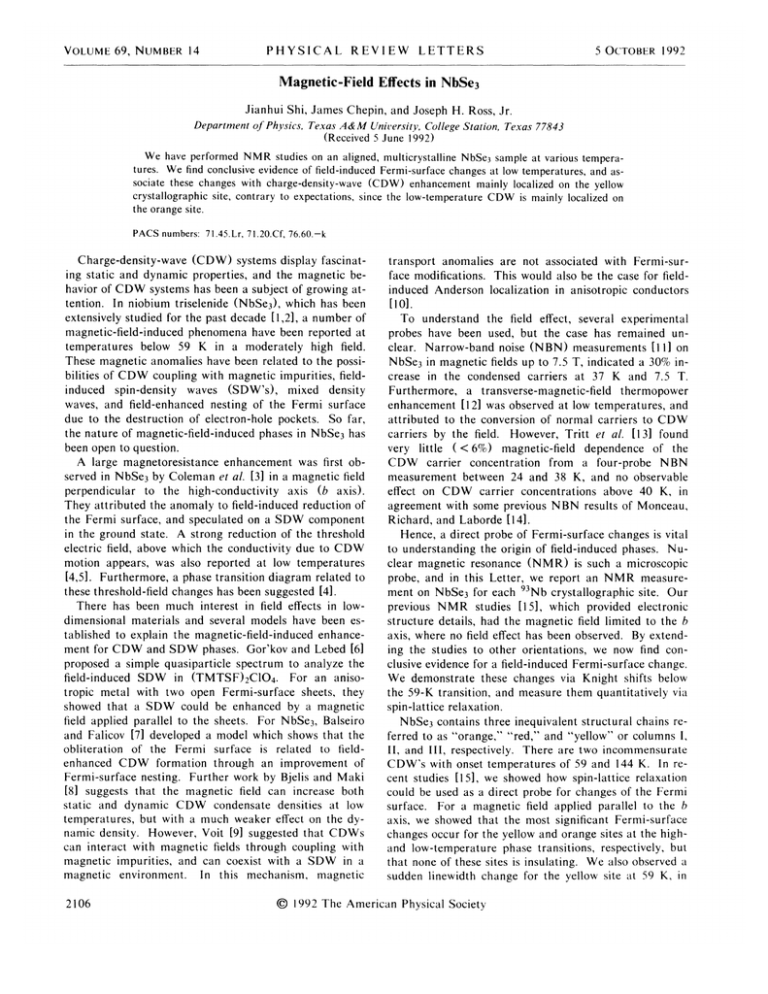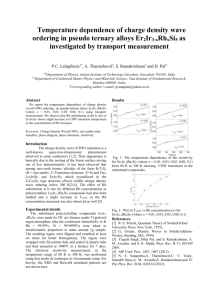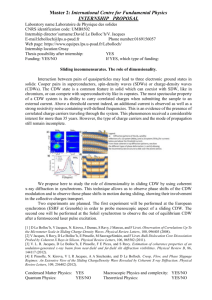LETTERS
advertisement

VOLUME 69, NUMBER 14 PH YSICAL R EV I EW Magnetic-Field Department LETTERS 5 OCTOBER 1992 Effects in NbSe3 Jianhui Shi, James Chepin, and Joseph H. Ross, Jr. of Physics, Texas ASM University, College Station, Texas 77843 (Received 5 June 1992) We have performed NMR studies on an aligned, multicrystalline NbSe3 sample at various temperatures. We find conclusive evidence of field-induced Fermi-surface changes at low temperatures, and associate these changes with charge-density-wave (CDW) enhancement mainly localized on the yellow crystallographic site, contrary to expectations, since the low-temperature CDW is mainly localized on the orange site. PACS numbers: Charge-density-wave 71.45. Lr, 71.20.Cf, 76.60.—k (CDW) systems display fascinat- properties, and the magnetic behavior of CDW systems has been a subject of growing attention. In niobium triselenide (NbSes), which has been extensively studied for the past decade [1,2], a number of magnetic-field-induced phenomena have been reported at below 59 K in a moderately high field. temperatures These magnetic anomalies have been related to the possibilities of CDW coupling with magnetic impurities, fieldinduced spin-density waves (SDW's), mixed density waves, and field-enhanced nesting of the Fermi surface due to the destruction of electron-hole pockets. So far, the nature of magnetic-field-induced phases in NbSe3 has been open to question. A large magnetoresistance enhancement was first observed in NbSe3 by Coleman et al. [3] in a magnetic field axis (b axis). to the high-conductivity perpendicular They attributed the anomaly to field-induced reduction of the Fermi surface, and speculated on a SDW component in the ground state. A strong reduction of the threshold electric field, above which the conductivity due to CDW motion appears, was also reported at low temperatures [4, 5]. Furthermore, a phase transition diagram related to these threshold-field changes has been suggested [4]. There has been much interest in field eAects in lowdirnensional materials and several models have been esenhancetablished to explain the magnetic-field-induced ment for CDW and SDW phases. Gor'kov and Lebed [6] proposed a simple quasiparticle spectrum to analyze the field-induced SDW in (TMTSF)2C104. For an anisotropic metal with two open Fermi-surface sheets, they showed that a SDW could be enhanced by a magnetic field applied parallel to the sheets. For NbSe3, Balseiro and Falicov [7] developed a model which shows that the obliteration of the Fermi surface is related to fieldenhanced CDW formation through an improvement of Fermi-surface nesting. Further work by Bjelis and Maki [8] suggests that the magnetic field can increase both static and dynamic CDW condensate densities at low temperatures, but with a much weaker eAect on the dynamic density. However, Voit [9] suggested that CDWs can interact with magnetic fields through coupling with magnetic impurities, and can coexist with a SDW in a In this mechanism, magnetic environment. magnetic ing static and dynamic 2106 transport anomalies are not associated with Fermi-surface modifications. This would also be the case for fieldinduced Anderson localization in anisotropic conductors [10]. To understand the field eAect, several experimental probes have been used, but the case has remained unclear. Narrow-band noise (NBN) measurements [11] on NbSe3 in magnetic fields up to 7. 5 T, indicated a 30% increase in the condensed carriers at 37 K and 7. 5 T. Furthermore, a transverse-magnetic-field thermopower enhancement [12] was observed at low temperatures, and attributed to the conversion of normal carriers to CDW carriers by the field. However, Tritt et al. [13] found dependence of the very little ( 6%) magnetic-field CDW carrier concentration from a four-probe NBN measurement between 24 and 38 K, and no observable eAect on CDW carrier concentrations above 40 K, in agreement with some previous NBN results of Monceau, Richard, and Laborde [14]. Hence, a direct probe of Fermi-surface changes is vital to understanding the origin of field-induced phases. Nuclear magnetic resonance (NMR) is such a microscopic probe, and in this Letter, we report an NMR measurement on NbSe3 for each Nb crystallographic site. Our previous NMR studies [15], which provided electronic structure details, had the magnetic field limited to the b axis, where no field eA'ect has been observed. By extending the studies to other orientations, we now find conclusive evidence for a field-induced Fermi-surface change. We demonstrate these changes via Knight shifts below the 59-K transition, and measure them quantitatively vi spin-lat tice relaxation. NbSe3 contains three inequivalent structural chains referred to as "orange, "red, and "yellow" or columns I, II, and III, respectively. There are two incommensurate CDW's with onset temperatures of 59 and 144 K. In recent studies [15], we showed how spin-lattice relaxation could be used as a direct probe for changes of the Fermi surface. For a magnetic field applied parallel to the b axis, we showed that the most significant Fermi-surface changes occur for the yellow and orange sites at the highand low-temperature phase transitions, respectively, but that none of these sites is insulating. We also observed a sudden linewidth change for the yellow site at 59 K, in ( 1992 The American Physical Society & " " VOLUME YSICAL PH 69, NUMBER 14 R EV I EW addition to the broadening at 145 K, which implies a changing yellow site in the low-temperature CDW transition, contrary to previous expectations. The aligned multicrystalline NbSe3 sample used here, the same as that used previously [15], contains nominally pure crystals exhibiting sharp CDW conduction thresh(FFT) NMR spectromolds. The fast-Fourier-transform eter was operated in a fixed magnetic field of 8.97 T. Our measurements concern the central transitions, the m = 2 Nb. For these transitions, to m = —2 lines for 2 the resonance frequencies are determined by Knight shifts due to spin and orbital moments of the conduction electrons and quadrupole shifts due to electric field gradients [16]. Spectra for 77 and 4. 2 K, in a magnetic field perpendicular to the b and c axes, are exhibited in Fig. 1. Exhave already well established the tensive measurements identity of these NMR sites [17]. Frequency changes for the yellow and orange sites between these temperatures indicate considerable electronic structure modifications. The orange-site shift is associated with the 59-K CDW transition as already observed [15,17, 18], and the line is CDW in the usual broadened by the incommensurate manner [17]. The linewidth and line shape are unchanged below 42 K for the orange site, indicating no further changes of the orange-site CDW modulation at On the other hand, the large yellowlow temperatures. site shift has a different temperature dependence, not seen with the field parallel to the b axis. Figure 2 shows the temperature dependence of the orange- and yellow-site shifts with the same field orientation as Fig. 1. We see that the increase of the yellow-site resonance frequency begins at about 40 K and saturates near 15 K, and this is associated with partial destruction of the Fermi surface of that site. Note that this is the ~ ~ 1 I= 4.2 K LETTERS 5 OCTOBER 1992 temperature region where a phase transition has been suggested [4]. On the other hand, no change of the orange-site resonance frequency is observed at low temperatures, just as the linewidth and line shape do not change. Associating the resonance shift with specific electronic changes is complicated by possible quadrupole- as well as Knight-shift changes, and since for the Knight shift both orbital and core polarization terms contribute [16]. However, spin-lattice relaxation is comparatively simple, due to domination by core polarization, and thus provides a direct quantitative probe of Fermi-surface changes. Based on band structure calculations [19,20], there is no s-contact contribution to Ti, and the orbital contribution also goes to zero since i(k, mlL —ik', m')i terms are negligible due to the absence of a d„„d~, mixture at the Fermi surface. Therefore core polarization dominates the relaxation, giving [16] 1/Ti =2y„hk[N(EF)] H, rT, where T i is spin-lattice relaxation time, H, z is the hyperfine core-polarization field, N(EF) is the density of states, and y„ is the gyromagnetic ratio. Interference terms [16] will not appear because there is essentially one orbital of importance, the d, 2 orbital. This has already given a good picture for measurements with the magnetic field along the b axis [15], where no field effect has been inobserved, and is confirmed by the field-orientation dependence now observed above the 59-K transition (see below). We applied a steady-state method in the T I measurements. An eight-echo Carr-Parcell-Meiboom-Gill pulse sequence was used, with each echo separately averaged, adding echo FFT's after multiplying by a weighting function, to optimize the signal-to-noise ratio. We determined signal strengths by integrating the echo FFT for each site. Finally, signals obtained at diA'erent tempera- Orange 90 60-N 30-Q Q C' Q N ~ -150 -100 ~ ~ i ~ -50 ~ ~ f 0 ~ ~ ~ i 50 ~ ~ ~ t ~ 100 ~ O ~ 150 Offset frequency (KHz) FIG. 1. Central-transition Nb NMR line shapes measured at 77 and 4. 2 K in NbSe3. Measurements were taken at H =8.966 T, with field perpendicular to the b and c axes. Frequency denotes the oAset from 93.350 MHz. Identification with the three crystallographic sites is as shown. 0-Orange site ~ Yellow site -30--60-90 ~ 0 ~ ~ ~ I ~ I I ~ ~ ~ ~ ~ ~ ~ ~ ~ ~ I ~ ~ I 1 I ~ ~ ~ ~ ~ I ~ ~ ~ I ~ 1 ~ ~ I I ~ ~ ~ 10 20 30 40 50 60 70 80 90 Temperature (K) FIG. 2. Yellow- and orange-site resonance frequency as a function of temperature. Frequency represents the peak of resonance line shape and denotes the offset from 93.250 MHz. 2107 VOLUME 69, NUMBER 14 PH YSI CA L R EV I E'A/' LETTERS 5 OCTOBE, R 1992 Nb NMR spin-lattice relaxation time (T[) measured for each site in NbSe3, at temperatures, at H=8. 966 T with the field perpendicular to the b and c axes. Data with field parallel to the b axis, from previous results [15], are also shown. TABLE I. different Red site Temp. (K) 4. 2 77 292 HJ (b, c) 40. 5+ 1.4 (II) Orange site HJ (b, c) Hllb s 26. 6+ 1.8 s 430+ 18 ms 410+ 22 ms 72+ 6 ms 67.3+ 2.4 ms were g awhile spin-lattice d, 2108 Yellow site Hi (b, c) 50. 1+ 1.4 s 24+ 3 ms 21 ~ 1 18.7+ 1.2 s 330+ 16 ms 12.6+ 0.7 ms 14+ 2 ms ms (II I) Hllb 25. 5+ 1. 1 s 23. 5 ~ 1.4 s 165 + 4 ms 165 + 9 ms 340 ~ 10 ms fitted to the theoretical recovery curve. relaxation is a multiexponential expression for the steady state [15], only two parameters were adjusted in the fit: T~ and the asymptote. The final T] figures for the three sites at three temperatures are given in Table I. The uncertainties correspond to the 90%-confidence level obtained from the fit. Compared with our previous data with field parallel to the b axis, we can see that T] for all three sites remains unchanged at 292 and 77 K, consistent with the corepolarization model. However, there is a large increase in T] for the yellow site at 4. 2 K with the field perpendicular to the b axis, while T] for the orange site remains unchanged, consistent with the unchanged Knight shift, linewidth, and line shapes at low temperatures for that site. To verify the Korringa form of relaxation, we measured T] at 2 K with the magnetic field parallel to the b axis. The T~ for all these sites is consistent with the Korringa relation between 4. 2 and 2 K, characteristic of metallic electrons. Thus mechanisms such as quadrupole relaxation are excluded for NMR. On the other hand, we note that for nuclear-quadrupole-resonance (NQR) measurements of the yellow site at 4. 55 MHz, we have observed somewhat faster relaxation at 4. 2 K than for high-field NMR, with a distinctly non-Korringa temperaThis can be attributed to quadrupole ture dependence. effects, for which the NMR and NQR recovery curves are rather different. This may account for the generally shorter average T~ in an earlier study [21]. Details of the NQR measurements will be reported separately. In addition, we neglected the oribtal T] contribution based on the lack of d„„d,, mixture at the Fermi surface [19,20]. or d~, mixture were found at the But even if a strong Fermi surface, a simple calculation shows that the observed factor of 3 change in T] for the yellow site cannot correspond to a field-independent density of states. While several other mechanisms may enhance the relaxation, we show that these are not important at the temperatures and fields used here, so that T] can indeed provide a direct probe of the Fermi-surface electrons in this system. Coherence effects below CDW transitions can cause non-Korringa relaxation, much as in superconductors [22]. This has been observed in SDW studies [23] and may also account for NQR observations [24] in NbSe~ near 145 K. This term appears near the transition tures (I) Hllb and falls exponentially with decreasing temperature, and the Korringa temperature dependence we observed between 2 and 4. 2 K indicates that any such term is unimportant at these temperatures. Another enhancement mechanism is electron diffusion in quasi-one-dimensional conductors, with sufficient anisotropy [25] so that the impurity scattering time (r) exceeds the interchain tunneling time (r j ). For NbSe3, where dipolar relaxation can be neglected [15], T~ ' field dependence only for co, T ~ 1 would have a ~ ro, r j. (ru, is the electron spin frequency). However, based on the observed resistance anisotropy in NbSe3 (a 6 factor of 30), r & would be on the order of ~30(b/vF) x10 ' s ll]. On the other hand, for our nominally pure 4 & 10 ' s at low temperatures [5,26]. Thus sample, r we expect no enhancement since NbSe3 is not sufticiently anisotropic. This is borne out by the above-mentioned ' NQR results, in which a small enhancement of T~ at zero field and 4. 2 K (a factor of 2 above the NMR) can effects, consistent with a be attributed to quadrupole field-independent magnetic T]. We used a core-polarization hyperfine field (H, ~) equal to —0. 18&&10 G, the experimental value for NbSe2 [27] to calculate for the density of states from Eq. (1). Theoretical H, values for Nb metal range from —0. 14x 10' to p—0.21&&10' G [15]; choosing values in this range will scale N(EF) accordingly, but relative N(EF) changes reported here will not be affected. For 292 and 77 K, it is apparent from Table I that N(EF) is the same for both orientations, which agrees with the fact effect has been observed that no magnetic-field-induced at these temperatures, For 4. 2 K, N(EF) for all sites and both orientations is shown in Table II. Comparing [15], we can see that the yellow site exhibits a large N(EF) change, a 39% reduction, due to the 8.97-T transverse field. There is also an 0 = = TABLE I I. states/[eV(Nb Densities of states at the Fermi surface, in atom)], for each Nb site at 4. 2 K with the field to the b and c axes. Data with field parallel to perpendicular the b axis, from previous results Orientations H & (b, c) H lib Red site (I I) 0.49 0.60 [15], are also Orange site 0.64 0.64 (I) shown. Yellow site (I I I) 0.43 0.71 VOLUME 69, NUMBER l4 PH YSICAL REV I EW 18% further reduction of N(EF) for the red site at 4. 2 K, in the magneticindicating some red-site involvement induced phase. [Note that the red-site N(EF) has been observed to change in both CDW transitions. ] On the other hand, there is no field-induced N(EF) change for the orange site at 4. 2 K, again consistent with the Knight shift and line shapes observed. The natural assumption has been that field-induced Fermi-surface changes below 59 K are connected to the orange site, since the 59-K CDW is apparently located mainly on that site [15, 18,28]. We have seen that other sites remain conducting and participate in this CDW transition [15], and we now demonstrate that the yello~ and red sites dominate the magnetic eAect. Hence, summing the contributions in Table II, there is 20% further reduction of the density of states at the Fermi surface at 4. 2 K in 8.97 T, when the orientation changes from parallel to the b axis to perpendicular to the b and c axes. This is in qualitative agreement with rough estimates from magnetoresistivity changes showing Fermi-surface modification in a transverse magnetic field similar to ours [11,13]. However, our line shapes suggest that if a SDW component exists at low temperature, it will be less than 10 ptt in Nb d orbitals, given the Nb hyperfine field. We conclude that the Fermi-surface changes must be associated with a CDW enhancement, which is consistent with the Balseiro and Falicov model [7]. Our results indicate that the yellow-site CDW is enhanced by the magnetic field below 59 K, since we find that the CDW-broadened orange line is completed unchanged at low temperatures, while we see large frequency shifts as well as a large T~ change for the yellow site. This can happen since the formation of the 59-K CDW modifies the band structures: Bands associated with the yellow and red sites become modified so that they are susInvolveceptible to field-induced CDW enhancement. ment of all sites in the low-temperature CDW transition has already been observed [15]. The fact that the fieldinduced enhancement is mainly on the yellow-site (144K) CDW can explain the small magnetic-field effect on narrow-band noise at low temperatures [13). In conclusion, we provide a quantitative picture of magnetic-field-induced changes at the Fermi surface below the 59-K transition in NbS3. We measured line shifts and T]'s, and demonstrated that T~ provides a direct probe of the Fermi-surface changes. We associated these Fermi-surface changes with field-induced CDW enhancement. We also showed that field-induced CDW enhancement is mainly localized on the yellow site through electronic structure modifications of the lowtemperature CDW transition. Note that NMR has been instrumental in studying the materials that exhibit fieldinduced SDW's [29], but this study is the first to measure field-induced Fermi-surface changes directly. LETTERS 5 OCTOBER l 992 Acknowledgement is made to the Donors of The Petroleum Research Fund, administered by the American Chemical Society, for partial support of this research. and A. Zettl, Phys. Rep. 119, 117 (1985). [2] Joseph H. Ross, Jr. , and Charles P. Slichter, in "Nuclear Spectroscopy of Charge-Density-Wave Systems, edited by T. Butz (Reidel, Dordrecht, to be published). [3] R. V. Coleman et al. , Phys. Rev. Lett. 55, 863 (1985). [4] P. Monceau and J. Richard, Phys. Rev. 8 37, 7982 [1] G. Griiner " (1988). [5] R. V. Coleman et al. , Phys. Rev. 8 41, 460 (1990). [6] L. P. Gor'kov and A. G. Lebed, J. Phys. (Paris) Lett. 45, L433 (1984). [7] C. A. Balseiro and L. M. Falicov, Phys. Rev. 8 34, 863 (1986). [8] A. Bjelis and K. Maki, Phys. Rev. 8 42, 10275 (1990). [9] J. Voit, J. Phys. C 21, L649 (1988). [10] Nicolas Dupuis and Gilles Montambaux, Phys. Rev. Lett. 6$, 357 (1992). [11] M. F. Hundley, P. Parilla, and A. Zettl, Phys. Rev. 8 34, 5970 (1986). [12] M. F. Hundley and A. Zettl, Solid State Commun. 61, 587 (1987). [13] T. M. Tritt et al. , Phys. Rev. 8 43, 7254 (1991). [14] P. Monceau, J. Richard, and O. Laborde, Synth. Met. 19, 801 (1987). [15] Jianhui Shi and Joseph H. Ross, Jr. , Phys. Rev. 8 45, 8942 (1992). [16] A. Narath, in Hyperftne Interactions, edited by A. J. Freeman and R. B. Frankel (Academic, New York, 1967), p. 287. [17] Joseph H. Ross, Jr. , Zhiyue Wang, and Charles P. Slichter, Phys. Rev. 8 41, 2722 (1990); Joseph H. Ross, Jr. , thesis, University of Illinois at Urbana-Champaign, 1986 (unpublished). [18] F. Devreux, J. Phys. (Paris) 43, 1489 (1982). [191 Nobuyuki Shima, J. Phys. Soc. Jpn. 52, 578 (1983). [20] E. Canadell et al. , Inorg. Chem. 29, 1401 (1990). [21] Shinji Wada, Ryozo Aoki, and Osamu Fujita, J. Phys. F 14, 1515 (1984). [22] L. C. Hebel and C. P. Slichter, Phys. Rev. 113, 1504 (1959). [23] T. Takahashi, D. Jerome, and K. Bechgaard, J. Phys. (Paris) 45, 945 (1984). [24] B. H. Suits and C. P. Slichter, Phys. Rev. 8 29, 41 (1984). [25] F. Devreux, Phys. Rev. 8 13, 4651 (1976). [26] H. P. Geserich, in Physics and Chemistry of Materials with Low-Dimensional Structures, Part II, edited by Pierre Monceau (Reidel, Dordrecht, Holland, 1985), p. 111. [27] C. Berthier, D. Jerome, and P. Molinie, J. Phys. C 11, 797 (1978). [28] S. van Smaalen et al. , Phys. Rev. 8 45, 3103 (1992). [29] D. Jerome, F. Creuzet, and C. Bourbonnais, Phys. Scr. T27, 130 (1989). 2109





